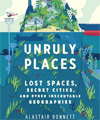July
Unleash your exploratory nature

It’s easy to believe that the whole world is mapped out for us today, but one academic suggests this is far from true.
Alastair Bonnett, Professor of Social Geography at Newcastle University, says there are still plenty of undiscovered places out there waiting for us to stumble upon.In his new book Unruly Places: Lost Spaces, Secret Cities and Other Inscrutable Geographies, which has just been published in the USA, he encourages people to step off the popular tourist trail and rediscover their inner explorer.
“We are exploratory animals who need to find new places and horizons,” he says. “It’s in our nature. We’re often given the impression that there’s nowhere left to explore anymore, and that’s a really limiting concept.
“It’s also not true – and you don’t have to fly halfway around the world to find something new – simply taking a different route on your commute can open up interesting places you never knew existed.”
Prof Bonnett, who will be talking about his research at the Edinburgh International Book Festival next month, took his own advice to heart while researching this book. This included crossing several lanes of motorway in Newcastle to reach a long-forgotten and unmapped triangular patch of land which stands marooned between passing traffic.
The book explores unlikely places that cannot be found on Google Maps or with a GPS device such as floating islands, secret cities and no-man’s lands lost between countries’ borders.
One of the strangest borders in the world is found in Baarle-Herztog and Baarle-Nassau: two villages that sit ‘on top of each other’, with 22 enclaves of Belgium inside the Netherlands and inside these, six parts belonging to the Netherlands. Prof Bonnett was able to cross five national borders in under a minute because of the sheer number that exist in this small community.
Prof Bonnett also looks at ‘dead cities’, such as the utopian ruins found in Giarre on the east coast of Sicily. “It’s a 20th century utopian version of a Greek ruin, with all these unfinished mega structures like Olympic-size swimming pools just decaying and being covered by vegetation and ash from Mount Etna,” he says. “It’s a fitting reminder that we’re still producing our own ruins today.”
Elsewhere, Pripyat, which is only a few miles from the Chernobyl nuclear plant, has been abandoned since 1986 when the entire population of 45,000 left and never returned. But their loss is nature’s gain – there is now an impressive number of animals and birds in the area, including bears, wolves, lynx and elk.
In the City of the Dead in Cairo, over half a million people live within five cemeteries. This city within a city has its own shops, electricity and running water. Several generations have been born there since it was occupied in the 1950s, with many sharing tombs with parents and grandparents.
In Unruly Places Prof Bonnett argues that many of the world’s most interesting places are not on any maps. “Places that are off the map intrigue and excite us today, perhaps because we have got used to the idea that world is fully known,” he says. “There are still plenty of places out there to feed our hunger for exploration but we need to start looking in hidden and long disregarded locations.”
Prof Bonnett & Tom Pow will be talking about Maps and The Imagination at the Edinburgh International Book Festival on Tuesday 19 August at 3.30pm.
published on: 14 July 2014
